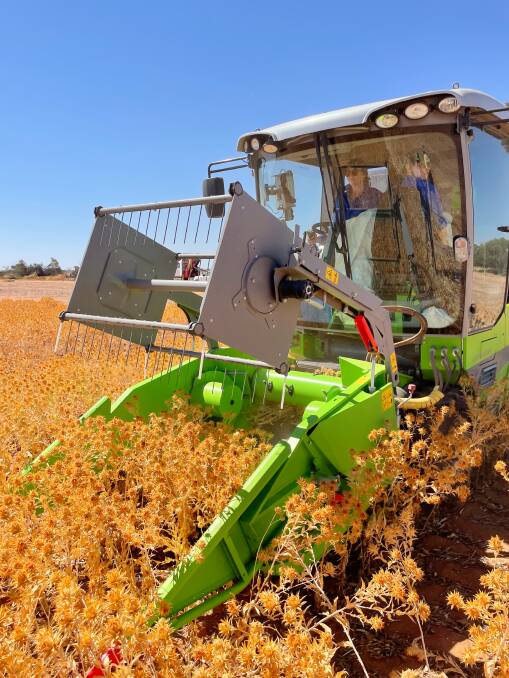
A NEW break crop suited to some of the most hostile soils in Western Australia and which can be used to make high-end machinery oil has been trialled across the grainbelt, with the initial results exceeding expectations.
Super high oleic (SHO) safflower was initially developed about 20 years ago as part of a joint venture between CSIRO and the Grain Research and Development Corporation (GRDC), with the oil profile modified to be more than 90 per cent oleic, which is the high quality portion.
While there are other crop species that have been modified in that way, such as soybeans and sunflowers, they are about 60-70pc, whereas the safflower's very high oleic levels means that when it is refined and extracted, it produces a higher oleic oil concentration.
Since the original creation, it has been further developed and marketed by GO Resources which holds the rights to the SHO trait that produces an oil used in top-end machinery, pharmaceuticals, cosmetics, cooking, plastics, polymers, resins and biofuel.
SHO safflower was tested at five sites in WA last year - Kalannie, Bodallin, Muntadgin, Tammin and York - and recent harvest results showed real potential as a new commercial crop for the Wheatbelt.
The trials were run by SLR Agriculture, the last of which were harvested at Kalannie on Friday, January 14, with most yields ranging between 1.4 tonnes per hectare to 1.6t/ha and some individual plots reaching up to 2/ha.
SLR Agriculture chief executive officer Michael Lamond said while it was a good season, the yields were still higher than they anticipated.
"Most of the trials were in the medium to low rainfall areas which is where we see this fitting," Mr Lamond said.
"It doesn't mind hostile subsoils that can be sodic and saline, which are around half our soil types in WA, and that natural adaptation is a really important factor.
"The standard crops that we grow don't actively forage for deep nutrients in those soils, whereas safflower can."
Safflower has the ability to follow moisture down and can access deep nutrients, such as nitrate, that are either too far down or associated with sodic and saline subsoils which most other crops aren't able to access.
Currently, there are no good break crop options for these soils and safflower has the potential to fill that gap.
Initially the fit will be in the medium to low rainfall regions on the valley floors, however as the breeding ramps up there may be the potential to position the crop in the higher rainfall regions to complement other established break crops.
Mr Lamond said safflower worked well as a break crop as it provided a complete nematode break, however it also had other advantages.
"It's a GM hybrid so the breeding advancements will be quick and even though it's a hybrid, it's essentially self-pollinating and the high oleic trait is conferred by a single dominant gene, which means growers will be able to retain seed," he said.
"Normally with a hybrid, such as canola, you don't retain seed because the out-crossing causes a quick dilution in the quality of future populations, which is why growers buy new hybrid seed for canola every year,
"However with safflower, that isn't the case and it's a major benefit, particularly in the low rainfall areas where growers need the flexibility with cropping systems to modify their seeding programs depending on the season."
Another advantage of SHO safflower over other boutique crops is that there are already markets for it.
That includes demand for India immediately for 100,000t of oil, which would require about 240,000t of grain production from WA, plus about 300,000t to the US, if that could be produced, along other global markets.
The main driver behind that demand is the top-end machinery industry, with SHO safflower making the perfect high quality machining oil as it's stable at a high temperature and has a long shelf-life.
Research completed by scientists at Montana State University Advanced Fuels Centre compared the performance of a lubricant oil formulation based on GO Resources super high oleic oil versus a synthetic lubricant oil.
That lubricant oil formulation showed reduced friction over synthetic oils by 83pc, reduced friction over conventional oils by 124pc, reduced tailpipe emissions by 48pc, reduced engine wear, increased fuel economy and reduced environmental contamination.
On top of all of that, currently a lot of oleic oil is from refined palm oil, which has a lower level of oleic (only 30-40 pc) and is not a sustainable production system, so in time it could be completely replaced by SHO safflower.
While it is early days and the crop has only been through one year of trials in WA, Mr Lamond said he would be very surprised if within the next 10 years there was not substantial area grown if the yield/price relationships stayed firm.
"There will be enough seed for about 2000ha this year and that will be split up amongst various regions where we think it will grow the best," he said.
"That will give growers across the State the chance to have a look at it on their own farms and it will probably ramp up fairly quickly after that if the yields hold up.
"However, we won't know until it's been grown across a range of seasons and environments."
GO Resources had also partnered with the Department of Primary Industries and Regional Development (DPIRD) for trials in Kununurra which helped to bulk up seed for further studies.
Want weekly news highlights delivered to your inbox? Sign up to the Farm Weekly newsletter.


